towing HONDA ACCORD HYBRID 2015 9.G Owners Manual
[x] Cancel search | Manufacturer: HONDA, Model Year: 2015, Model line: ACCORD HYBRID, Model: HONDA ACCORD HYBRID 2015 9.GPages: 569
Page 3 of 569
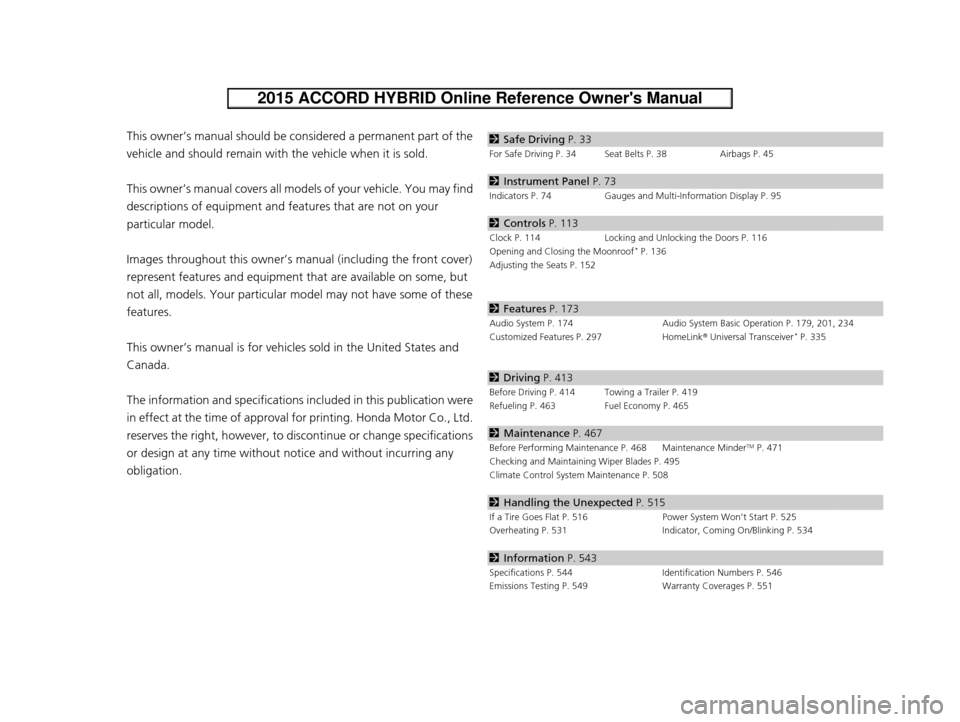
Contents
This owner’s manual should be considered a permanent part of the
vehicle and should remain with the vehicle when it is sold.
This owner’s manual covers all models of your vehicle. You may find
descriptions of equipment and features that are not on your
particular model.
Images throughout this owner’s manual (including the front cover)
represent features and equipment that are available on some, but
not all, models. Your particular mo del may not have some of these
features.
This owner’s manual is for vehicles sold in the United States and
Canada.
The information and specifications in cluded in this publication were
in effect at the time of approval for printing. Honda Motor Co., Ltd.
reserves the right, however, to discontinue or change specifications
or design at any time without notice and without incurring any
obligation.2 Safe Driving P. 33
For Safe Driving P. 34 Seat Belts P. 38 Airbags P. 45
2Instrument Panel P. 73
Indicators P. 74 Gauges and Multi-Information Display P. 95
2Controls P. 113
Clock P. 114 Locking and Unlocking the Doors P. 116
Opening and Closing the Moonroof* P. 136
Adjusting the Seats P. 152
2 Features P. 173
Audio System P. 174 Audio System Basic Operation P. 179, 201, 234
Customized Features P. 297 HomeLink® Universal Transceiver* P. 335
2 Driving P. 413
Before Driving P. 414 Towing a Trailer P. 419
Refueling P. 463 Fuel Economy P. 465
2Maintenance P. 467
Before Performing Maintenance P. 468 Maintenance MinderTM P. 471
Checking and Maintaining Wiper Blades P. 495
Climate Control System Maintenance P. 508
2Handling the Unexpected P. 515
If a Tire Goes Flat P. 516 Power System Won’t Start P. 525
Overheating P. 531 Indicator, Coming On/Blinking P. 534
2Information P. 543
Specifications P. 544 Identification Numbers P. 546
Emissions Testing P. 549 Warranty Coverages P. 551
15 ACCORD FHEV-31T3W6100.book 2 ページ 2014年7月23日 水曜日 午後3時10分
Page 4 of 569
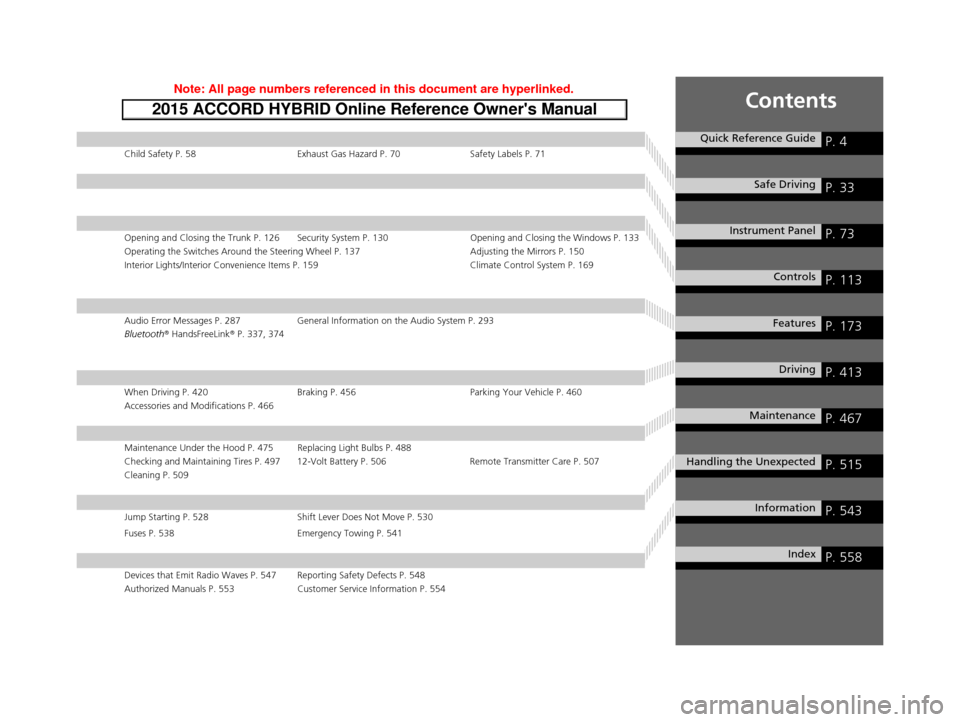
Contents
Child Safety P. 58Exhaust Gas Hazard P. 70Safety Labels P. 71
Opening and Closing the Trunk P. 126 Security System P. 130 Opening and Closing the Windows P. 133
Operating the Switches Around the Steering Wheel P. 137 Adjusting the Mirrors P. 150
Interior Lights/Interior Convenience Items P. 159 Climate Control System P. 169
Audio Error Messages P. 287General Information on the Audio System P. 293
Bluetooth® HandsFreeLink ® P. 337, 374
When Driving P. 420 Braking P. 456Parking Your Vehicle P. 460
Accessories and Modifications P. 466
Maintenance Under the Hood P. 475 Replacing Light Bulbs P. 488
Checking and Maintaining Tires P. 497 12-Volt Battery P. 506 Remote Transmitter Care P. 507
Cleaning P. 509
Jump Starting P. 528 Shift Lever Does Not Move P. 530
Fuses P. 538 Emergency Towing P. 541
Devices that Emit Radio Waves P. 547 Reporting Safety Defects P. 548
Authorized Manuals P. 553 Customer Service Information P. 554
Quick Reference GuideP. 4
Safe DrivingP. 33
Instrument PanelP. 73
ControlsP. 113
FeaturesP. 173
DrivingP. 413
MaintenanceP. 467
Handling the UnexpectedP. 515
InformationP. 543
IndexP. 558
15 ACCORD FHEV-31T3W6100.book 3 ページ 2014年7月23日 水曜日 午後3時10分
Page 30 of 569
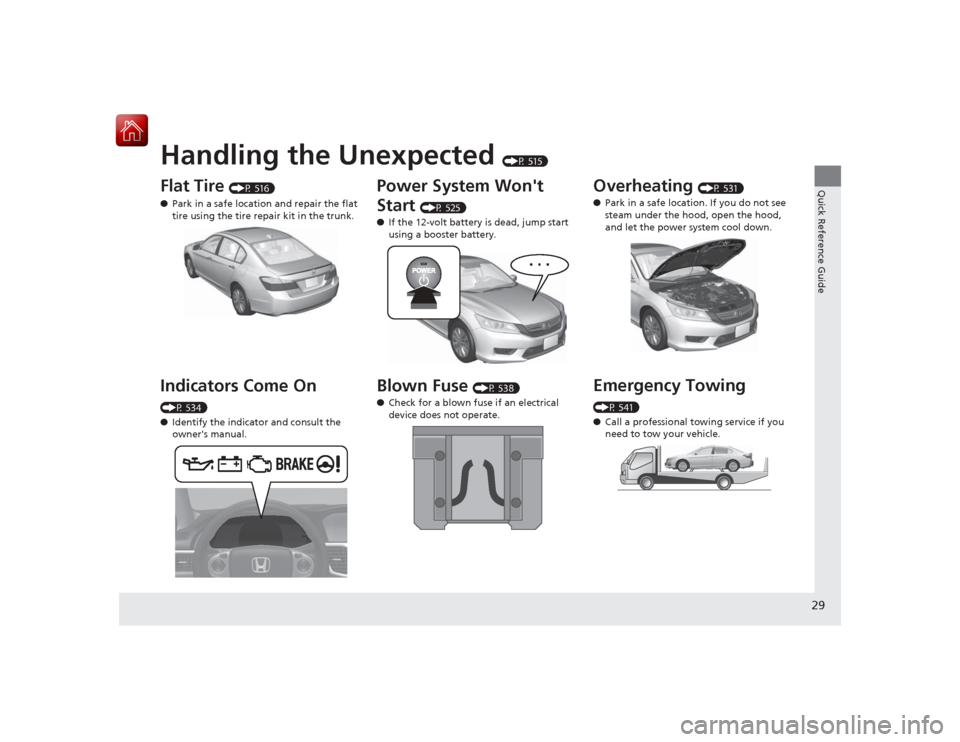
Quick Reference Guide29
Handling the Unexpected
(P 515)
Flat Tire
(P 516)
● Park in a safe location and repair the flat
tire using the tire repair kit in the trunk.
Indicators Come On (P 534)
●Identify the indicator and consult the
owner's manual.
Power System Won't
Start
(P 525)
● If the 12-volt battery is dead, jump start
using a booster battery.
Blown Fuse
(P 538)
● Check for a blown fuse if an electrical
device does not operate.
Overheating
(P 531)
● Park in a safe location. If you do not see
steam under the hood, open the hood,
and let the power system cool down.
Emergency Towing (P 541)
●Call a professional towing service if you
need to tow your vehicle.
Page 414 of 569
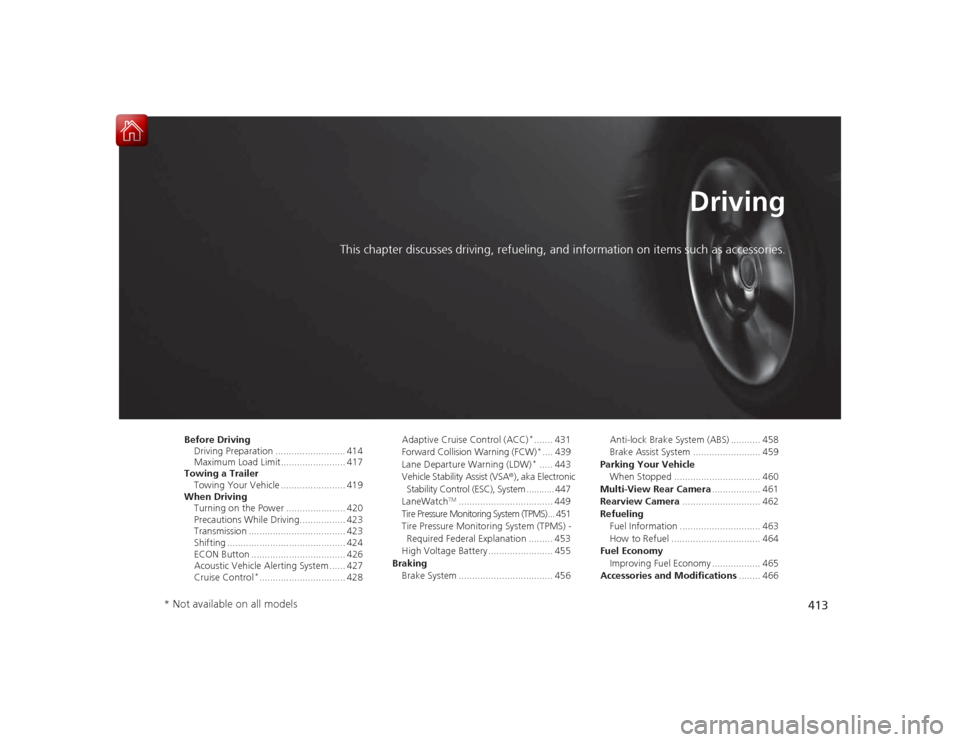
413
Driving
This chapter discusses driving, refueling, and information on items such as accessories.
Before DrivingDriving Preparation .......................... 414
Maximum Load Limit........................ 417
Towing a Trailer
Towing Your Vehicle ........................ 419
When Driving Turning on the Power ...................... 420
Precautions While Driving................. 423
Transmission .................................... 423
Shifting ............................................ 424
ECON Button ................................... 426
Acoustic Vehicle Alerting System ...... 427
Cruise Control
*................................ 428 Adaptive Cruise Control (ACC)
*....... 431
Forward Collision Warning (FCW)*.... 439
Lane Departure Warning (LDW)*..... 443
Vehicle Stability Assist (VSA® ), aka Electronic
Stability Control (ESC), System ........... 447
LaneWatch
TM................................... 449
Tire Pressure Monitoring System (TPMS) ... 451
Tire Pressure Monitoring System (TPMS) - Required Federal Explanation ......... 453
High Voltage Battery ........................ 455
Braking Brake System ................................... 456 Anti-lock Brake System (ABS) ........... 458
Brake Assist System ......................... 459
Parking Your Vehicle When Stopped ................................ 460
Multi-View Rear Camera .................. 461
Rearview Camera ............................. 462
Refueling Fuel Information .............................. 463
How to Refuel ................................. 464
Fuel Economy Improving Fuel Economy .................. 465
Accessories and Modifications ........ 466
* Not available on all models
Page 418 of 569
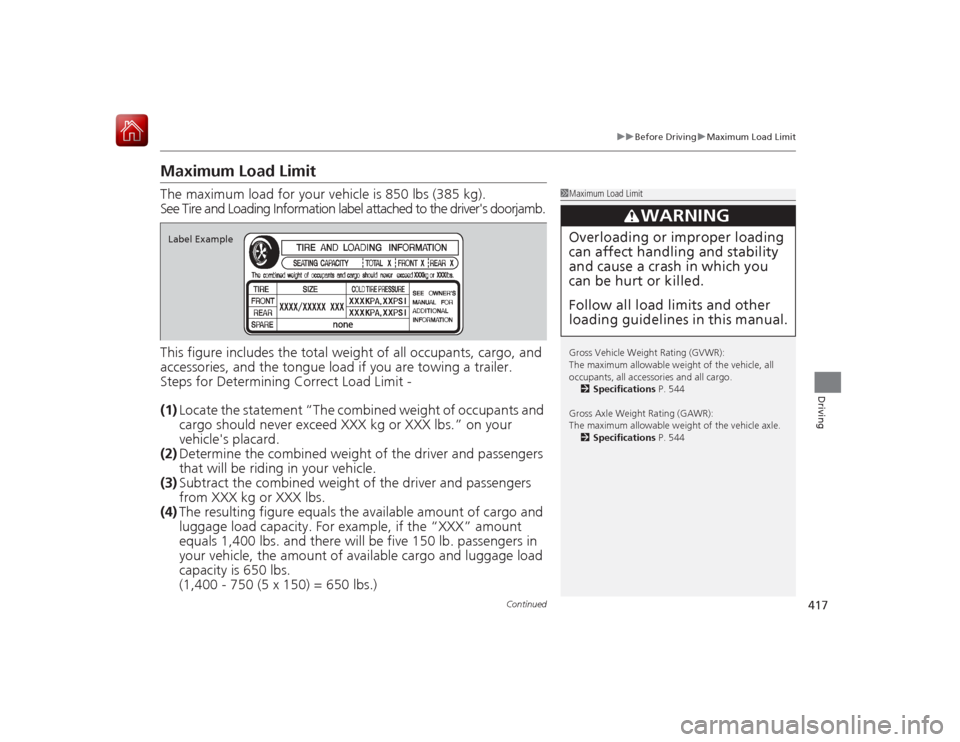
417
uuBefore Driving uMaximum Load Limit
Continued
Driving
Maximum Load LimitThe maximum load for your vehicle is 850 lbs (385 kg).
See Tire and Loading Information label attached to the driver's doorjamb\
.
This figure includes the total weight of all occupants, cargo, and
accessories, and the tongue load if you are towing a trailer.
Steps for Determining Correct Load Limit -
(1) Locate the statement “The combined weight of occupants and
cargo should never exceed XXX kg or XXX lbs.” on your
vehicle's placard.
(2) Determine the combined weight of the driver and passengers
that will be riding in your vehicle.
(3) Subtract the combined weight of the driver and passengers
from XXX kg or XXX lbs.
(4) The resulting figu re equals the availabl e amount of cargo and
luggage load capacity. For example, if the “XXX” amount
equals 1,400 lbs. an d there will be five 15 0 lb. passengers in
your vehicle, the amount of available carg o and luggage load
capacity is 650 lbs.
(1,400 - 750 (5 x 150) = 650 lbs.)
1 Maximum Load Limit
Gross Vehicle Weight Rating (GVWR):
The maximum allowable weight of the vehicle, all
occupants, all accessories and all cargo.
2 Specifications P. 544
Gross Axle Weight Rating (GAWR):
The maximum allowable weight of the vehicle axle. 2 Specifications P. 544
3
WARNING
Overloading or improper loading
can affect handling and stability
and cause a crash in which you
can be hurt or killed.
Follow all load limits and other
loading guidelines in this manual.
Label Example
Page 419 of 569
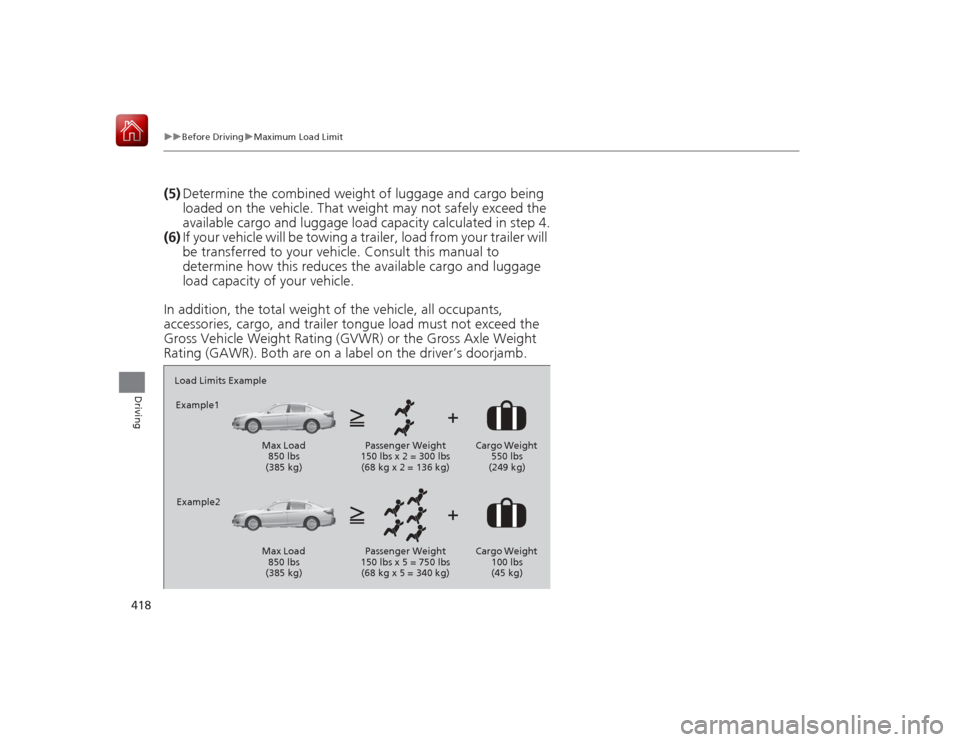
418
uuBefore Driving uMaximum Load Limit
Driving
(5) Determine the combined weight of luggage and cargo being
loaded on the vehicle. That weight may not safely exceed the
available cargo and luggage load capacity calculated in step 4.
(6) If your vehicle will be towing a trailer, load from your trailer will
be transferred to your vehicle. Co nsult this manual to
determine how this reduces the available cargo and luggage
load capacity of your vehicle.
In addition, the total weight of the vehicle, all occupants,
accessories, cargo, and trailer tongue load must not exceed the
Gross Vehicle Weight Rating (GVWR) or the Gross Axle Weight
Rating (GAWR). Both are on a lab el on the driver’s doorjamb.Load Limits Example
Example1
Max Load 850 lbs
(385 kg) Passenger Weight
150 lbs x 2 = 300 lbs (68 kg x 2 = 136 kg) Cargo Weight
550 lbs
(249 kg)
Example2
Max Load 850 lbs
(385 kg) Passenger Weight
150 lbs x 5 = 750 lbs (68 kg x 5 = 340 kg) Cargo Weight
100 lbs
(45 kg)
Page 420 of 569
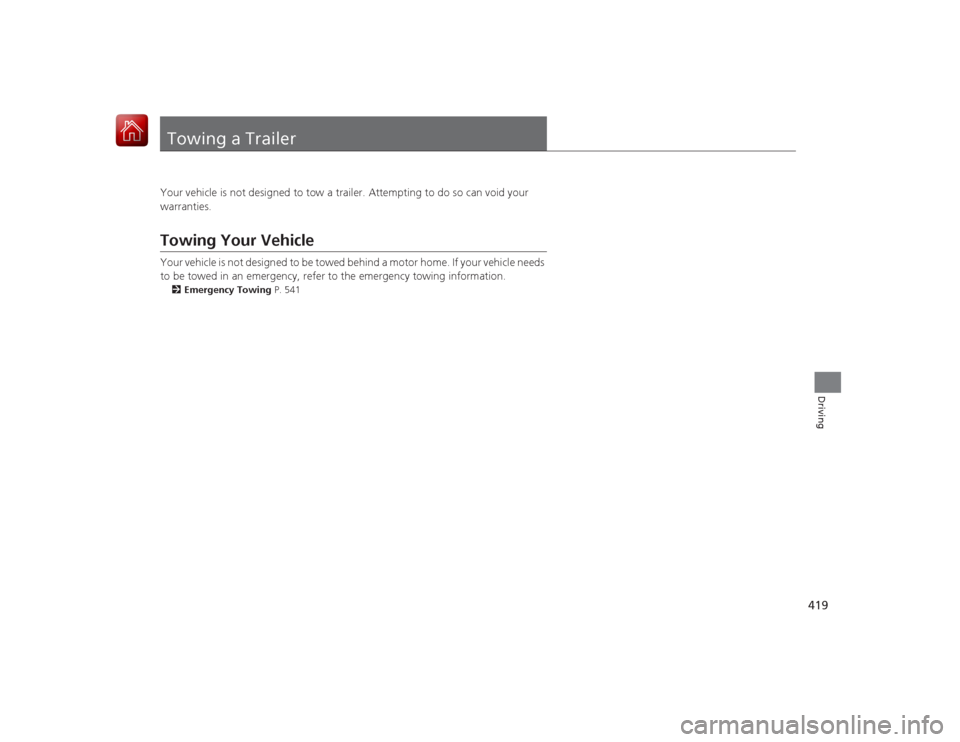
419Driving
Towing a TrailerYour vehicle is not designed to tow a trailer. Attempting to do so can void your
warranties.Towing Your VehicleYour vehicle is not designed to be towed behind a motor home. If your vehicle needs
to be towed in an emergency, refer to the emergency towing information.2Emergency Towing P. 541
Page 516 of 569
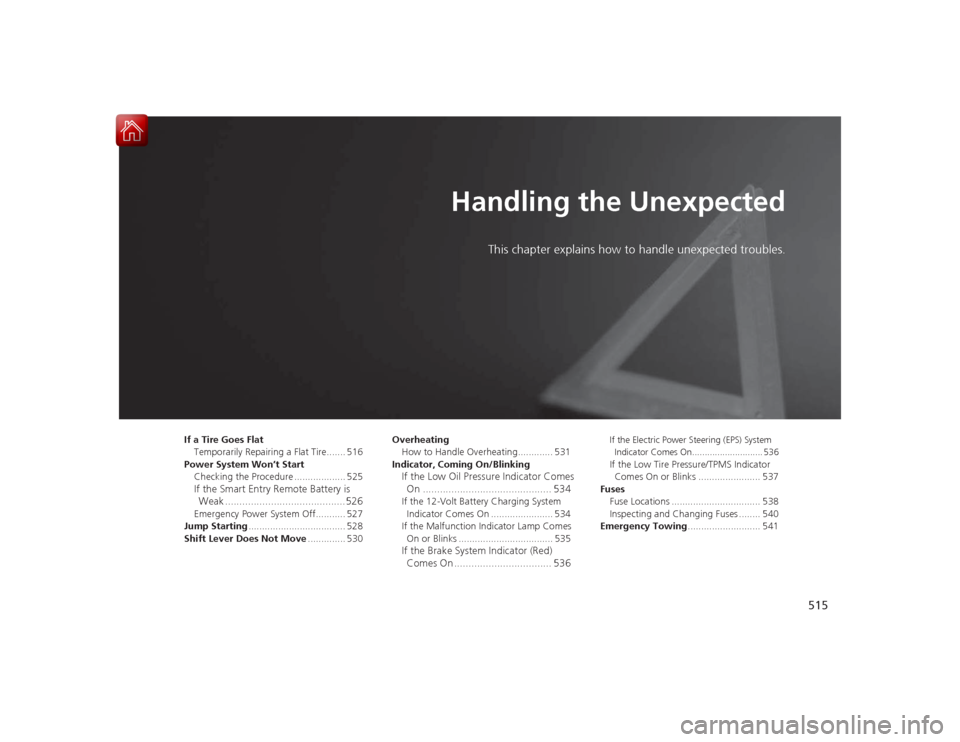
515
Handling the Unexpected
This chapter explains how to handle unexpected troubles.
If a Tire Goes Flat
Temporarily Repairing a Flat Tire....... 516
Power System Won’t Start Checking the Procedure ................... 525If the Smart Entry Remote Battery is Weak .......................................... 526Emergency Power System Off........... 527
Jump Starting .................................... 528
Shift Lever Does Not Move .............. 530Overheating
How to Handle Overheating............. 531
Indicator, Coming On/Blinking
If the Low Oil Pressure Indicator Comes On ............................................. 534If the 12-Volt Battery Charging System
Indicator Comes On ....................... 534
If the Malfunction Indicator Lamp Comes On or Blinks ................................... 535If the Brake System Indicator (Red) Comes On ........................... ....... 536
If the Electric Power Steering (EPS) System
Indicator Comes On............................ 536If the Low Tire Pressure/TPMS Indicator Comes On or Blinks ....................... 537
Fuses Fuse Locations ................................. 538
Inspecting and Changing Fuses ........ 540
Emergency Towing ........................... 541
Page 523 of 569
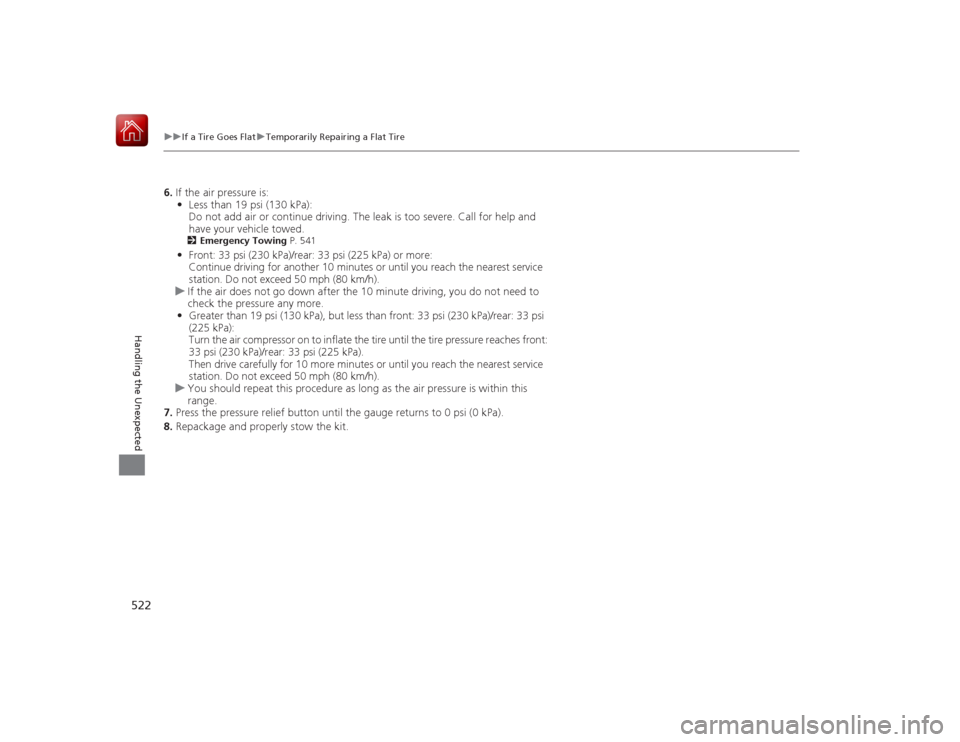
522
uuIf a Tire Goes Flat uTemporarily Repairing a Flat Tire
Handling the Unexpected
6. If the air pressure is:
• Less than 19 psi (130 kPa):
Do not add air or continue driving. The leak is too severe. Call for help and
have your vehicle towed.
2 Emergency Towing P. 541•Front: 33 psi (230 kPa)/rear: 33 psi (225 kPa) or more:
Continue driving for another 10 minutes or until you reach the nearest service
station. Do not exceed 50 mph (80 km/h).
u If the air does not go down after the 10 minute driving, you do not need to
check the pressure any more.
• Greater than 19 psi (130 kPa), but less than front: 33 psi (230 kPa)/rear: 33 psi
(225 kPa):
Turn the air compressor on to inflate the tire until the tire pressure reaches front:
33 psi (230 kPa)/rear: 33 psi (225 kPa).
Then drive carefully for 10 more minutes or until you reach the nearest service
station. Do not exceed 50 mph (80 km/h).
u You should repeat this procedure as long as the air pressure is within this
range.
7. Press the pressure relief button until the gauge returns to 0 psi (0 kPa).
8. Repackage and properly stow the kit.
Page 542 of 569
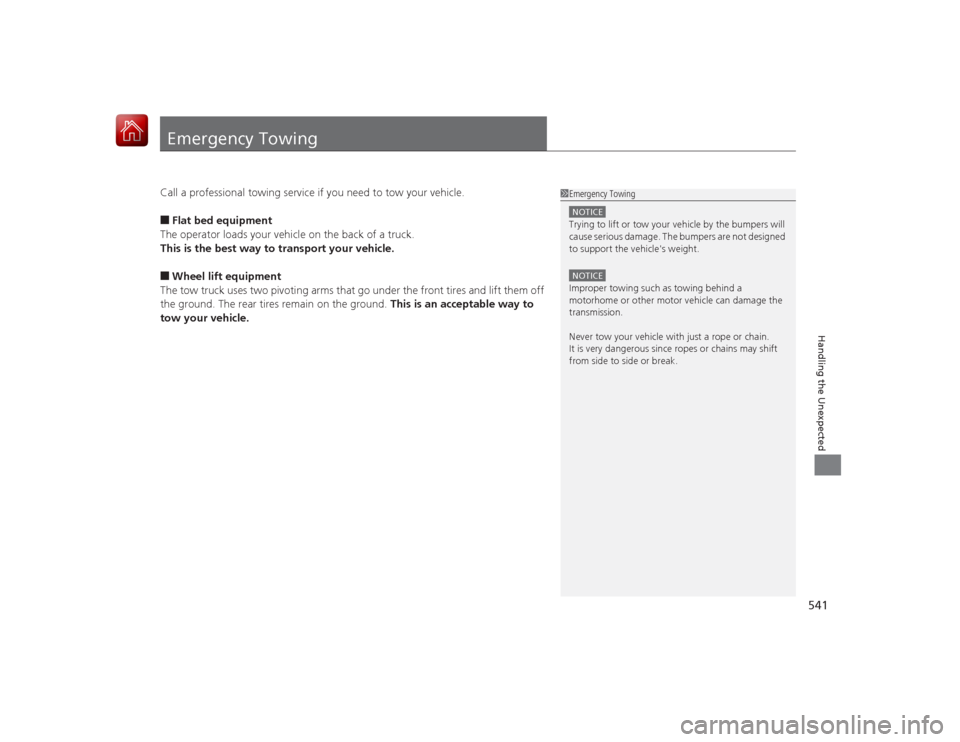
541Handling the Unexpected
Emergency TowingCall a professional towing service if you need to tow your vehicle.■Flat bed equipment
The operator loads your vehicle on the back of a truck.
This is the best way to transport your vehicle.■Wheel lift equipment
The tow truck uses two pivoting arms that go under the front tires and lift them off
the ground. The rear tires remain on the ground. This is an acceptable way to
tow your vehicle.
1 Emergency TowingNOTICETrying to lift or tow your vehicle by the bumpers will
cause serious damage. The bumpers are not designed
to support the vehicle's weight.NOTICEImproper towing such as towing behind a
motorhome or other motor vehicle can damage the
transmission.
Never tow your vehicle with just a rope or chain.
It is very dangerous since ropes or chains may shift
from side to side or break.